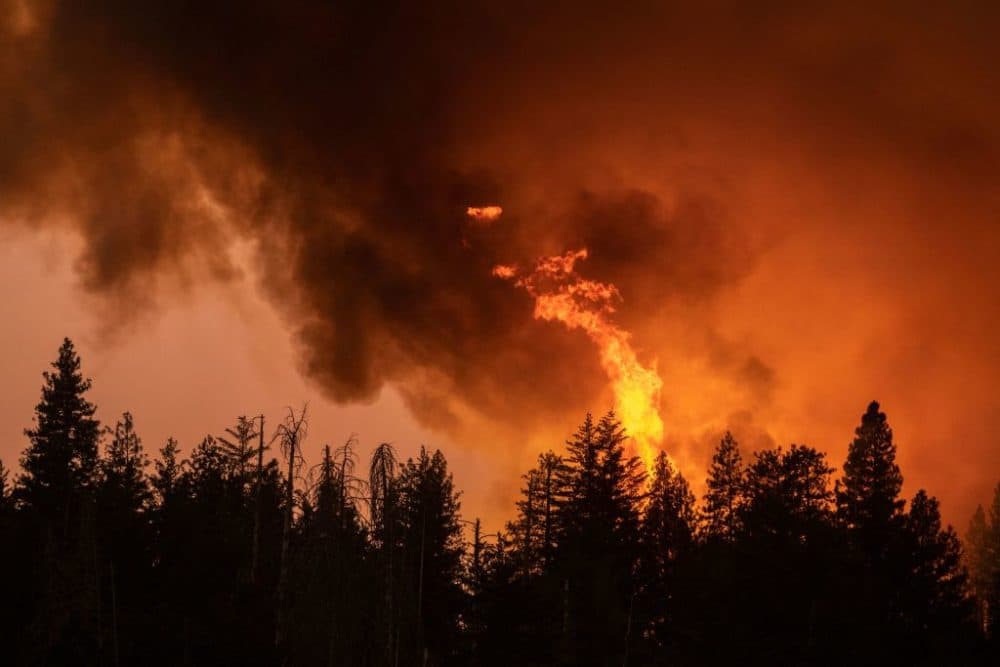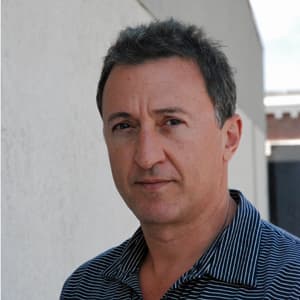Advertisement
Journalist David Wallace-Wells on climate change and climate hope
Resume
Sign up for the On Point newsletter here.
When the U.N. Secretary General says this to the world --
"We are on a highway to climate hell with our foot still on the accelerator."
… It’s hard not to despair.
But journalist David Wallace-Wells says there's reason for hope. He's been writing about climate for years. And he says, there's progress.
"Five years ago, certainly ten years ago, most climate scientists thought that we were heading for four or five degrees of warming," Wallace-Wells says.
"Now, most of them would say we're heading for about two or three degrees. So roughly half what we thought we were heading for."
That doesn't mean that carbon reduction efforts should stop. But Wallace-Wells says focusing too much on climate doom is stopping us from making critical, permanent changes.
"We have to start thinking about what it means to navigate a world that is post normal, post safe, and yet sub-apocalyptic," Wallace-Wells says.
Today, On Point: David Wallace-Wells on climate change and climate hope.
Guests
David Wallace-Wells, columnist for the New York Times Magazine and an opinion writer for the New York Times. Author of The Uninhabitable Earth: Life After Warming. (@dwallacewells)
Also Featured
Brett Hartl, government affairs director for the Center for Biological Diversity. (@brett_hartl)
Carroll Muffett, CEO and president of the Center for International Environmental Law.
Interview Highlights
Are we hurtling our way to climate catastrophe and an uninhabitable Earth?
David Wallace-Wells: "I wouldn't say an uninhabitable earth. There are parts of the planet that are, of course, pretty hard to live in. And probably those will grow over the coming decades. And I do think that story is a really important one. Things are going to get worse from here. Climate damage is growing. Climate suffering will grow, too. And we're not moving nearly fast enough to secure the sort of future that a generation ago we might have hope for. But there's another story, too. And that's the one that I wrote about a few weeks ago.
Things are getting worse from here. But the distant future doesn't look nearly as grim as it looked five years ago.
"And that's about the worst-case scenario is becoming considerably less likely to. So, things are getting worse from here. But the distant future doesn't look nearly as grim as it looked five years ago. In fact, a lot of the things that we were worrying about then seem almost impossible to imagine today. And I think few people really appreciate or understand that. In part because the news outside their windows and on their social media feeds is of an ever-intensifying climate crisis. And as I said a minute ago, that story is true. The climate crisis is getting worse. But at the same time, thanks to a number of factors, the world turning away from coal, a global political awakening.
"Leaders in the corporate world and in the public sector are taking climate change really seriously for the first time. And perhaps most significantly, there's incredible technological progress with the price of renewable energy making it cheaper, almost everywhere in the world than dirty energy.
"For all these reasons, we now no longer see an emissions trajectory taking us to 4 or 5 degrees Celsius of warming, which is about three or four times as much as we've seen to this point, but rather somewhere between 2 and 3 degrees of warming. And that means that we've basically cut in half our expected temperature rise in just about five years.
"We're still going to shoot past the thresholds that scientists have told us mark the difference between safe and unsafe warming. And we're going to end up quite likely in an area, at a temperature level that they describe as dangerous or even catastrophic. But we're much, much less likely to end up in this sort of truly apocalyptic futures that seemed not just plausible but sort of important to imagine just a few years ago. And I think given the landscape of things, we have to have a way to see that progress and appreciate it, too."
Leaders in the corporate world and in the public sector are taking climate change really seriously for the first time.
Do you actually feel a little less wedded to the concept of doom with climate?
David Wallace-Wells: "I did call myself an alarmist, and that's because I was alarmed about what I saw coming. And I'm still alarmed, I think, even at 2 degrees of warming, which I think is maybe not exactly our best-case scenario, but sort of an optimistic future from where we are today. Even at 2 degrees, we're talking about climate disruption, unprecedented in the history of humanity. And I don't think we're anywhere near prepared for that. So, I remain alarmed.
"But coming down from a baseline of expecting twice as much, or more warming than that, things are looking considerably smoother than they looked to me a few years ago. And that's because the world has actually started taking action here. Five years ago, ten years ago, climate activists might say, totally defensively, nobody is paying attention. Nobody is doing anything. The world is not acting as though this is an existential threat. It's not even really acting as though it's a threat at all. And those critiques are no longer valid. The world is moving. We're not moving fast enough. We're not decarbonizing fast enough.
"That's why we're likely to pass these thresholds that scientists have called dangerous or catastrophic in the past. And yet we're moving quite quickly. There's been more investment made last year in renewable energy than in dirty energy. I heard yesterday that 90% of the new energy capacity that was added last year was in renewables. We're turning the corner.
"We're still doing way too much damage, in fact, because we haven't yet reached an emissions peak. We're doing more damage this year than we've ever done in any previous year in the history of humanity. But we now see a near-term future in which we reach a peak and begin to decline. In fact, that's what the International Energy Agency, which tends to be a conservative forecaster, predicted would happen over the next five or seven years, just last week."
We're doing more damage this year than we've ever done in any previous year in the history of humanity.
On pushback against Wallace's argument
Brett Hartl: "The differences between 1 degree of warming, and 2 degrees of warming and 3 degrees of warming is, in fact, devastating suffering for billions of people around the world. And he sort of casually writes that off as almost a given, and that we should embrace the fact that I guess it's not worse than that."
" ... It's true that we are in a better place than we were five years ago and ten years ago, and we are making progress. But the U.N., IPCC and other reports are still saying that most government promises, and most government actions are still very inadequate. And so, we should celebrate the progress we've made. But I think we shouldn't equivocate or sort of, as the author says, normalize ... additional warming."
On adapting to our new climate reality
David Wallace-Wells: "I live in New York City, where we're now talking seriously about building a series of sea gates to enclose the New York harbor that will cost tens of billions of dollars. There's a project like that being undertaken off the Texas coast as well, designed by the Army Corps of Engineers. There are also slightly less expensive but still quite complicated projects to do similar work to prevent coastal flooding with restoration of wetlands and mangrove forests. We also need to think about designing new kinds of crops or cultivating new kinds of crops that can thrive more through drought and heat than the ones that we've been using for the last decades or centuries. We need to think about building a lot of cooling infrastructure, not just in the hottest parts of the world, but in almost all of the world.
"Cities whereby, you know, in summer, but in the second half of the century, we're going to be having some days that are hot enough to really cause public health crises if we don't take steps now to prepare for them. And those are just a handful of the changes that are needed. The truth is, life is going to be disrupted dramatically at almost every level. And that means that our response has to be similarly all encompassing and total. This is a global infrastructure project to build a new adaptive capacity to allow us to thrive in the new climate future. And that's quite an ambitious, large-scale undertaking. In addition to the Industrial Revolution scale undertaking that we have to complete to decarbonize all of those systems at the same time."
Life is going to be disrupted dramatically at almost every level. And that means that our response has to be similarly all encompassing and total.
On building climate hope
Brett Hartl: "It's sort of like going to the moon, right? You set a broad vision and say, we're going to get to the moon. We know it's going to be tricky and difficult. But when you set the vision as aggressively as possible, that does give people hope. It does inspire folks. Can you imagine if the message was we're going to go to the moon? Maybe or not, but half the rockets are going to blow up and other people will suffer. That's not as inspiring a message."
David Wallace-Wells: "That landscape is getting much, much messier and much, much more jagged. And what kind of future we build on it is really as important a question we are going to be asking ourselves over the next few decades as the question of how much we can do to limit global warming.
"What can we do, given that level of warming, to make sure that the future that we share on this planet, the billions of us that are living here, is, relatively speaking, more full of prosperity, more full of justice, more full of human flourishing and human equity. And those are open questions that are more political than scientific ones.
"I think that's ... I hope one of the main themes of my piece. Is that in narrowing our range of climate temperatures, we now have to ask ourselves a somewhat harder set of questions about just how we're going to distribute these burdens and responsibilities going forward. A harder set of questions about a new kind of climate politics that goes beyond the simple project of decarbonization and into areas of how we protect the most vulnerable among us from the impacts we know now are inevitable."
What can we do, given that level of warming, to make sure that the future that we share on this planet ... [is] full of human flourishing and human equity.
Related Reading
New York Times: "Beyond Catastrophe: A New Climate Reality Is Coming Into View" — "You can never really see the future, only imagine it, then try to make sense of the new world when it arrives."
New York Times: "Envisioning Life After Climate Change" — "Climate change has led to roughly 1.2 degrees Celsius of warming so far, making the earth hotter now than it has ever been in the long history of civilization."
This program aired on November 8, 2022.

